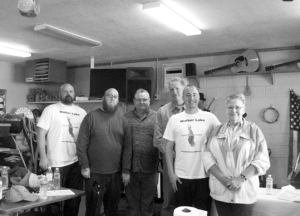
Darren Hamrey opened with an overview of The Walker Lake Crusaders mission. This grassroots group began in 2003 with a handful of high school students from Hamrey’s government class at Mineral County High School. Its vision was to create attention to the failing lake and it’s struggling eco system. Hamrey had his own love for the lake, so he was glad to find students that embraced such a cause.
In an effort to create awareness, the Crusaders have had letter writing campaigns to keep government officials mindful of the lake. Once as young people, they staged a peaceful protest on the steps of the Capital in Carson City, and over the years expanded into creating literature and posters about the lake using their own time and money. Over time the initial group members dwindled down to a small core group but their mission has remained true.
Hamrey explained, “I’ve never had as dedicated a group as I did in 2003 when the first Crusaders committed to save Walker Lake, but Toby Montoya, Casey Kee and myself have remained faithful to this cause over all these years. We have stood on the decision that this was not just what you do – it was who you are. You either care, or you don’t. The three of us have made this a lifetime concern and heartfelt desire to see Walker Lake survive, in spite of the negativity that surrounds it. It is a beautiful lake that brings tourists and drivers to stop their cars, just to take a picture. Keeping the shoreline clean and the lake presentable is one concern, but continuing to spread the truths about our lake is a heavy part of our endeavors.”
Montoya reviewed the importance of keeping the plight of Walker Lake in social media platforms. His goal has not only been physically cleaning the shores with Kees, but creating literature which the public can view at information boards, especially at the State Beach.
The Walker Lake Crusaders website references vital information, photos and updates, which he monitors. Montoya said that many that view the website are from Russia, most likely due to the interest in terminal lakes.
Montoya spoke of communicating to one college professor that had negatively commented about the extreme spider issues around the lake last summer.
He was able to present the reason surrounding the excessive spiders stating, “This is a man-made issue. By interfering with the natural Eco system many years ago, it eliminated the natural cycle of fish eating the insects and the birds and fowl have been misplaced. The natural flow of water was interrupted long ago and as man tampers with the earth’s natural flow there will be repercussions.
We know the struggles and realize the needs, but even small, positive steps can and will make a difference.”
Another guest was Elmer Bull from The National Fish and Wildlife Foundation. He was able to update everyone on the details of NFWF’s involvement in bringing water back to Walker Lake.
Bull addressed the simple fact that a federal decree called C125 was instituted in 1936 which dictated that the water be reassigned, with a basic premise that no water would move beyond Shurz. Back then, it was deemed to be used primarily for agricultural use rather than reaching lake. No one would have foreseen the extreme drought conditions and faltering water levels which the lake would gradually incur back then.
Bull explained the current procedures pursued over the last few years was NFWF getting involved in obtaining crucial land strips back. He said, “We had to sit down to create a fair, stipulated agreement so no one would be adversely effected and all parties would realize the importance of Walker Lake’s survival. It has been a slow process which involved State Engineers and in-depth research. Water is a high commodity for everyone and a high emotional issue. Everyone along the stream of this need had to be heard, with new ideas and decisions of fairness agreed upon. This required the cooperation of many organizations and individuals, but Walker Lake had been left out of the equation too long. Even the farmers are recognizing a need to adapt changes to their overall crops and watering patterns, out of necessity.”
Bull explained that the first water application is sitting at the Federal Court, awaiting a signature to approve the Walker Basin Restoration and recovery effort. Other applications will follow to secure the complete plan.
Nevada Senator Harry Reid and many other congressional leaders have deemed this to be a worthwhile endeavor, so grant money and other donations have sponsored this undertaking. Conveyance agreements have been signed and most have been agreeable in restoring what was taken from this terminus lake so long ago.
Those in attendance were also able to access Glen and Marlene Bunch who represented The Walker Lake Working Group. Many questions and concerns were discussed in an open forum, while this helpful panel shared current facts and vital information. Each of the three groups shared their website information and encouraged continued involvement from the community.


